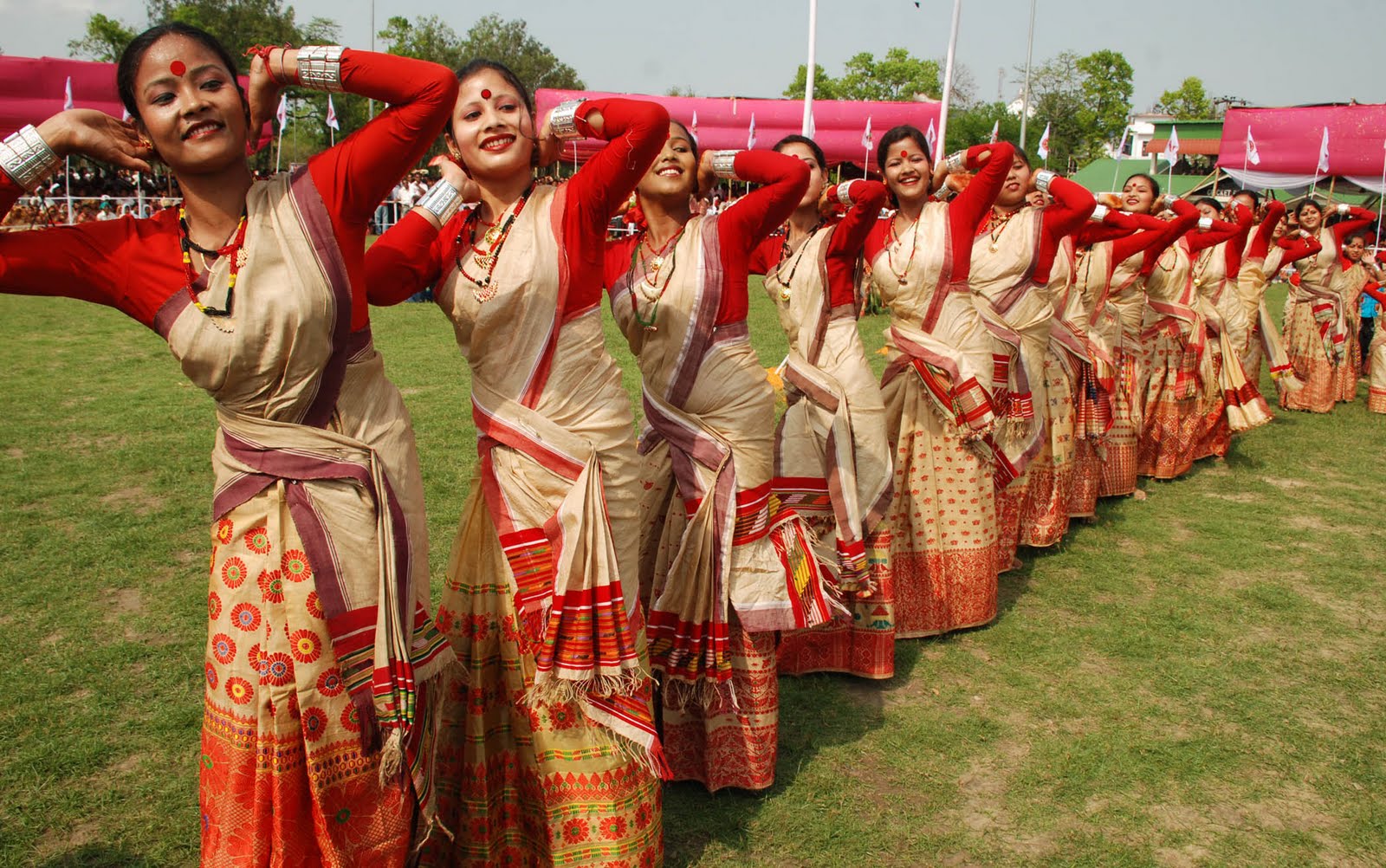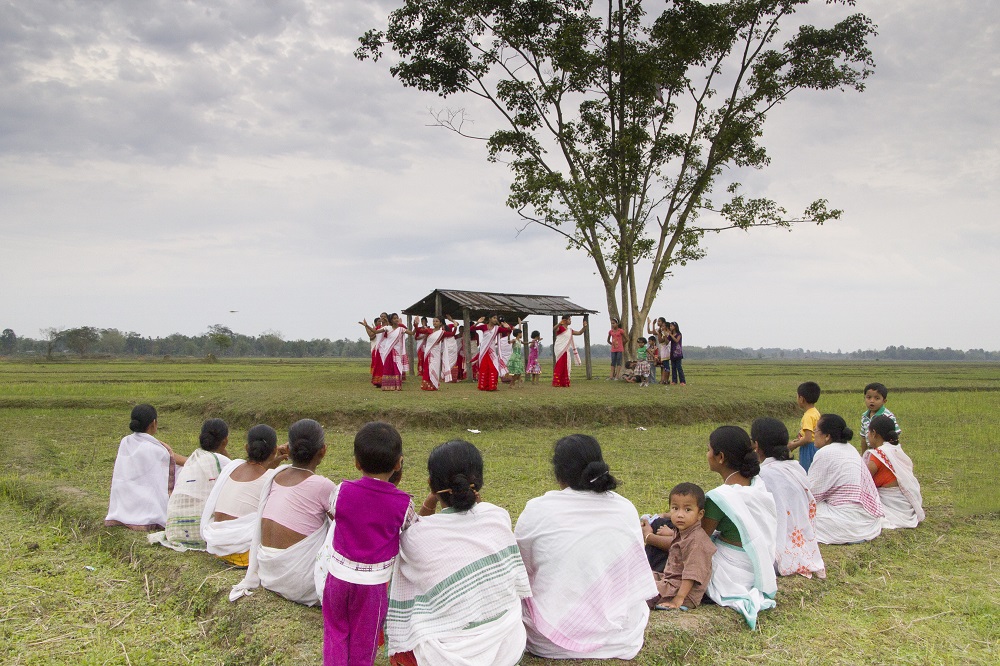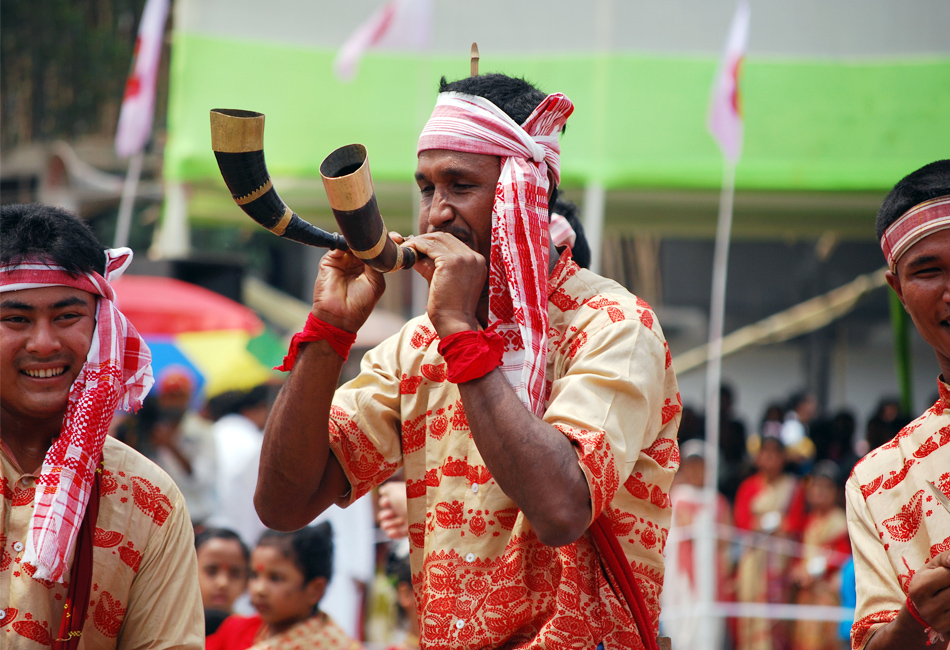Bihu is a set of festivals of Assam and celebrated by the Assamese diaspora around the world. Bihu is celebrated thrice every year - in the months of Bohaag (Baisakh, the middle of April), Maagh (the middle of January), and Kaati (Kartik, the middle of October). The Bihus have been celebrated in Assam since ancient times. Each Bihu coincides with a distinctive phase in the farming calendar. It is one of the festivals of India which focuses on nature worshiping and not idol worshiping. The word Bihu is derived from the language of the Dimasa people. Bi means "to ask" and Shu means "peace". The word Bishu gradually became Bihu to accommodate linguistic preferences.  All the three Bihus are associated with farming; as the traditional Assamese society is predominantly agricultural. In fact, similar festivals are also celebrated around the same time elsewhere in India. Bihu is also celebrated overseas by the Assamese community living in different countries around the globe. The timings of the three Bihus are significant too. Rongali Bihu, for example, draws from many different traditions— Austro-Asiatic, Sino-Burmese and Indo-Aryan—and is celebrated with great fervor. Celebrations begin in the middle of April and generally continue for a month. This is their traditional new year. Kongali Bihu is associated with the September equinox in October, while Bhogali Bihu is associated with the January solstice.
All the three Bihus are associated with farming; as the traditional Assamese society is predominantly agricultural. In fact, similar festivals are also celebrated around the same time elsewhere in India. Bihu is also celebrated overseas by the Assamese community living in different countries around the globe. The timings of the three Bihus are significant too. Rongali Bihu, for example, draws from many different traditions— Austro-Asiatic, Sino-Burmese and Indo-Aryan—and is celebrated with great fervor. Celebrations begin in the middle of April and generally continue for a month. This is their traditional new year. Kongali Bihu is associated with the September equinox in October, while Bhogali Bihu is associated with the January solstice.
Bohag Bihu
Bohag Bihu (also called Rangali Bihu or Haat Bihu) marks the beginning of the Assamese New Year around mid-April, historically signifying the time of harvest. This marks the first day of the Hindu solar calendar and is also observed in Mithila, Bengal, Manipur, Nepal, Odisha, Punjab, Kerala and Tamil Nadu though called by different names. While farmers prepare the fields for cultivation of paddy and there is a feeling of joy around, families make pitha, larus and jolpan. The first day of the Bihu is called goru (cow) Bihu, where the cows are washed and worshipped, which falls on the last day of the previous year. This is followed by manuh (human) Bihu on April 15, the New Year Day. This is the day of getting cleaned up, wearing new cloths and celebrating and getting ready for the New Year with fresh vigor. The third day is Gosai (gods) bihu; statues of Gods, worshiped in all households are cleaned and worshiped asking for a smooth new year. The festival continues for seven days, known as 'Chot', 'Raati', 'Goru', 'Manuh', 'Kutum', 'Mela' and 'Chera'. Rongali Bihu is also a fertility festival, where the Bihu dance with its sensuous movements using the hips, arms, etc., by the young women call out to celebrate their fertility. In this aspect, the Bihu dance can also be called a mating ritual by the young men and women. 
Kongali Bihu
Kongali Bihu has a different flavor as there is less merriment and the atmosphere has a sense of constrain and solemnity. During this time of the year, the paddy in the fields are in the growing stage and the granaries of the farmers are almost empty. On this day, earthen lamps (saki) are lit at the foot of the household tulsi plant, the granary, the garden (bari) and the paddy fields. To protect the maturing paddy, cultivators whirl a piece of bamboo and recite rowa-khowa chants and spells to ward off pests and the evil eye. During the evening, cattle are fed specially made rice items called pitha. The Bodo people light lamps at the foot of the siju tree. This Bihu is also associated with the lighting of lamps at the tip of a tall bamboo pole, to show the souls of the dead the way to heaven, a practice that is common to many communities in India, as well as Asia and Europe. 
Bhogali Bihu
Bhogali Bihu (also known as Magh Bihu) is a harvest festival celebrated in Assam, India, which marks the end of harvesting season in the month of Maagha It is the Assam celebration of Sankranthi, with feasting lasting for a week. During Bhogali Bihu, people make cakes of rice with various names such as Shunga Pitha, Til Pitha etc. and some other sweets of coconut called Laru. On the event of the festival, menfolk, more particularly young men go to the field, preferably near a river, build a makeshift cottage called Bhelaghar with the hay of the harvest fields and the bonfire or Meji, the most important thing for the night. During the night, they prepare food and there is community feasting everywhere. There is also exchange of sweets and greetings at this time. The entire night (called Uruka) is spent around a Meji with people singing bihu songs, beating drums or playing games. Boys roam about in the dark stealing firewood and vegetables for fun. The next morning they take a bath and burn the main Meji. People gather around the Meji and throw Pithas (rice cakes) and betel nuts to it while burning it at the same time. They offer their prayers to the God of Fire and mark the end of the harvesting year. Thereafter they come back home carrying pieces of half burnt firewood for being thrown among fruit trees for favourable results. The celebrations also feature traditional Assamese games such as tekeli bhonga (pot-breaking) and buffalo fighting. Though they own their origins to ancient rites and practices they have taken definite urban features and have become popular festivals in urban and commercialized milieus in the recent decades. Bihu is also used to imply Bihu dance and Bihu folk songs. Meanwhile, the three Bihus continue to be celebrated with fun in abundance by all Assamese people irrespective of caste, creed, and belief.
References:
https://en.wikipedia.org/wiki/Bihu https://en.wikipedia.org/wiki/Magh_Bihu https://en.wikipedia.org/wiki/Bohag_Bihu
